Agaves are striking architectural plants that thrive in hot, dry conditions. Their rosettes of stiff, spiky leaves come in a range of shapes like spirals, spears, and artichoke-like forms. Though agaves flower just once before dying, they produce new young plants called pups that let you expand your collection easily.
Learning how to properly plant agave pups ensures you can propagate these succulents at no cost. With a little know-how, you’ll soon have gorgeous new agaves to grow in garden beds or containers
Where Do Agave Pups Come From?
Agaves reproduce in two ways. First, they send up a tall flower stalk covered in blooms, then die after flowering. But years before that, they generate pups. An agave grows short underground stems called rhizomes from its base. At the end of the rhizomes form tiny new agaves called pups or offsets.
The small pups are attached to the parent plant underground, feeding off it until they produce their own roots. Eventually the connection withers away. Then the pups can be removed and planted independently, creating clones of the original agave.
How to Identify Agave Pups
Check around the base of your agave frequently to spot pups as soon as they emerge. Look for tiny rosettes forming around the mature agave. The tiny new plants will resemble miniature versions of the parent.
Some agave species, like Parry’s agave (Agave parryi) only produce a few pups at a time. But other kinds like century plant (Agave americana) pop them out prolifically, sometimes overrunning a space.
Recognizing pups early lets you remove them while still small for the easiest transplanting. Mature, large pups can also be planted, but require more work.
When to Remove and Plant Agave Pups
It’s best to detach agave pups when they are small, about 1/3 to 1/2 the size of the parent plant Carefully dig down to find the connecting rhizome and sever it with clean, sharp pruners.
Try to retain as many of the pup’s roots intact as possible. Quickly plant removed pups in prepared soil so roots don’t dry out.
Pups can technically be removed and planted any time, but spring and fall are ideal. Cooler temperatures help reduce transplant stress. Avoid planting in mid-summer when hot sun damages tender new roots.
How to Plant Agave Pups
Follow these steps to successfully plant your harvested agave pups:
-
Allow the cut end to callous over for 2-3 days before planting. Lay on dry soil out of direct sun. A callous forms to protect the wound.
-
Choose a site with full sun and well-draining soil. Amend clay soil with extra gritty material like sand or perlite.
-
Dig a hole at least twice as wide as needed for the pup. Spread out the roots in the hole; agaves have shallow, spreading roots.
-
Backfill with a 1:1 blend of cactus/succulent soil and native soil from the hole. Tamp down gently.
-
Create a water basin around the planted pup. Irrigate thoroughly until water drains out the bottom.
-
Add a layer of pebbles or gravel as mulch to retain moisture. Keep soil consistently damp until established.
-
Let the transplant dry slightly between waterings once roots form, usually within a few weeks.
Caring for Agave Pups
With proper planting and care, your new agave pups will flourish:
-
Water moderately until plants are established, then taper off.
-
Avoid overwatering, which rots tender new roots and crowns.
-
If planting in the ground, amend heavy or dense soil with extra gritty material.
-
Use cactus fertilizer a few times per year to support growth.
-
Protect pups from frost damage until well rooted by covering or moving into shelter.
-
Plant very tender varieties like Queen Victoria agave in containers that can move indoors in cold months.
Tips for Transplanting Large Agave Pups
Larger, older pups can also be transplanted, but require a bit more care:
-
Cut the connecting rhizome with a shovel, knife or saw.
-
Allow the cut end to callous over for a week before planting.
-
Dig an extra-wide hole to accommodate the agave pup’s size.
-
Carefully move the pup using lifting straps or rolling on pipe.
-
Pack soil firmly around the base to stabilize it. Stake tall leaves if needed.
-
Water thoroughly at planting time and provide supplemental irrigation while establishing.
With proper timing and care, those agave pups will reward you with unique new succulents to enjoy for years. And since agave pups are free, you can propagate plenty to share with gardening friends too!
Get My Free Guide to Gardening in the Desert
You’ll receive helpful tips from me into your inbox. I write these myself, with you in mind, to help you succeed in the desert garden. I will never share your information with anyone else. Of course, you can unsubscribe at any time.
Tag Archive for: How to Plant Agave pups
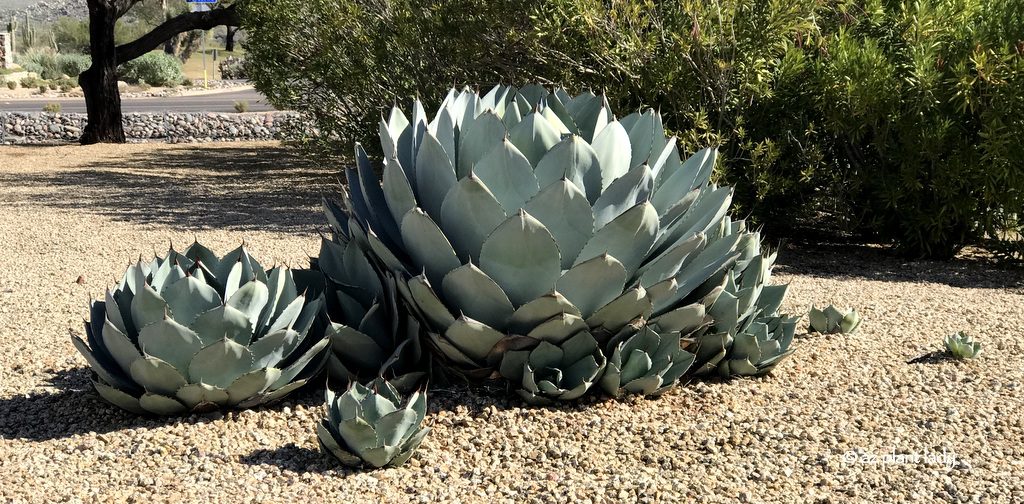
artichoke agave (Agave parryi ‘truncata’)
Today as I was downloading photos from my phone, this one caught my eye. It is a picture of an artichoke agave (Agave parryi ‘truncata’) along with her babies. For some reason, it spoke to me about family relationships. Some of her youngest kids are going too far, like when our kids were toddlers and they walked out into the street without being scared.
Some of her youngest kids are going too far, like when ours were toddlers and they walked out into the street without being scared. Then there are babies who are a little older—I like to call them “tweens”—but still want to be protected by their mom while looking out into the world.
Then there are the slightly older babies who are still hidden under their mother’s protective leaves. I like to call these babies “tweens” because they still feel safe under their mother’s care while looking out at the world’s wonders.
The medium-sized agave baby is the teenager who thinks they are independent but is actually still connected to their mother by an underground root. It’s like how they depend on their parents for money, their phone, and rides to and from school.
This one is my favorite because it shows how I feel about my two oldest daughters and their relationship with their mother. Even though they are different, they like being close to their mom and ask her for advice. They also like spending time together.
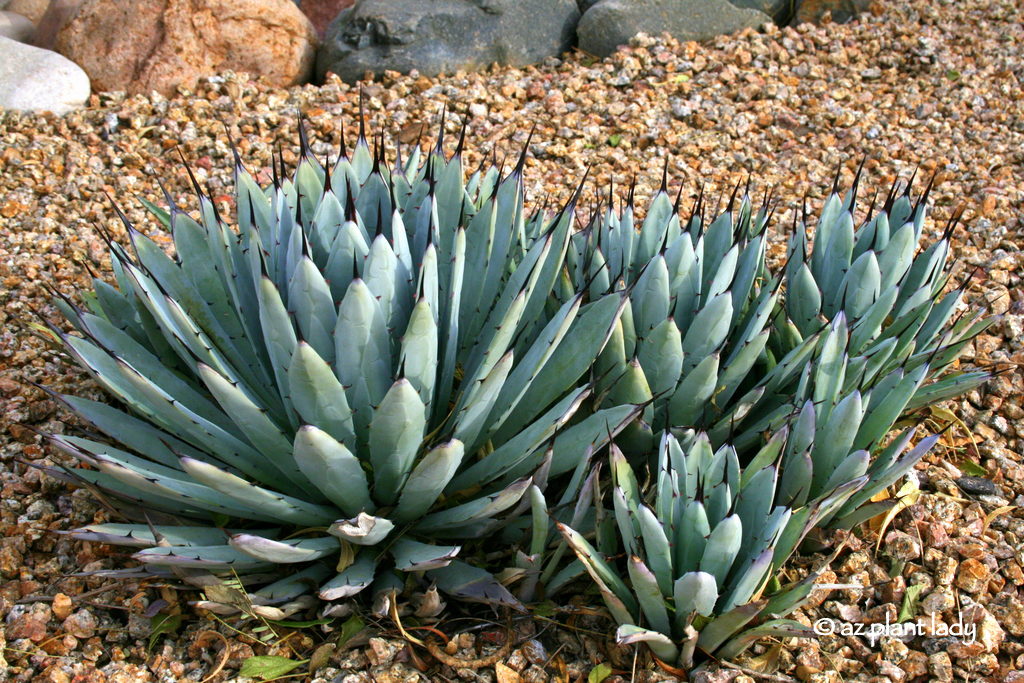
Black Spine Agave (Agave macroacantha)
A lot of different kinds of agave plants reproduce by making “pups,” which are connected to the parent plant by an underground stem. These new agave can be removed and replanted elsewhere in the landscape. It’s not hard to do and I wrote about how to do this, which you can read here.
Have you ever replanted an agave baby?
I am talking about Agave babies, which are known as ‘pups’.
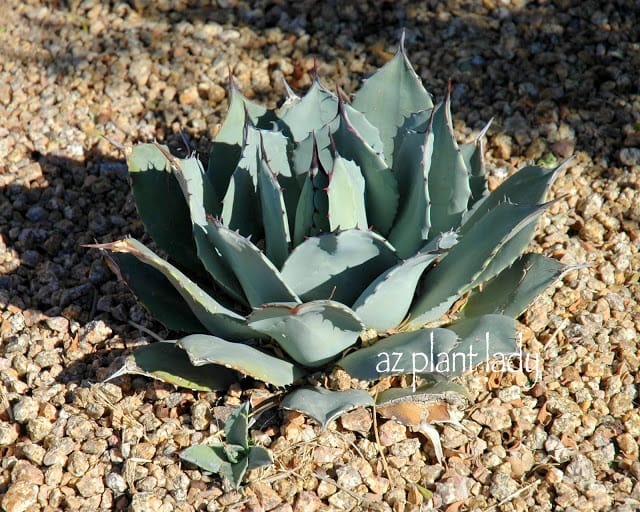
Parry’s Agave with small pup.
I knew that my Parry’s Agave, above, had a little pup growing. It has been getting bigger while I watch it. I want to give it some time to grow on its own before I take it away.
I didn’t mean to brag to my neighbors to the north, but it was a lovely day to be in the garden, so I took advantage of the sun’s warmth while I snapped pictures. It has been rather cold lately (for us desert dwellers anyway) and today was a beautiful 68 degrees.
*I promise I will be envying your weather come August….
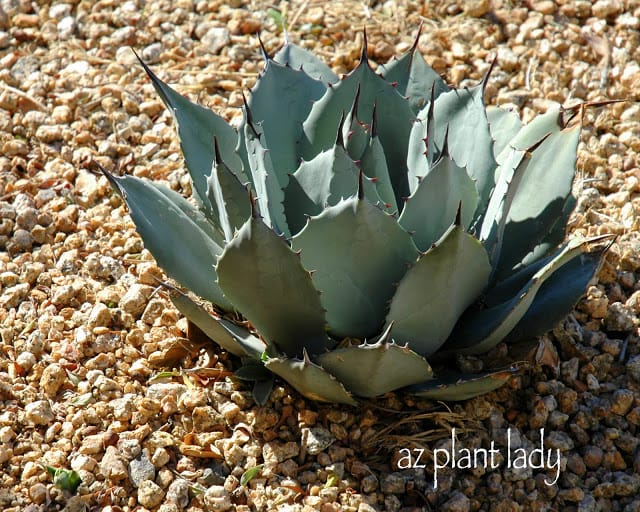
Yesterday, I saw the start of a little pup breaking through on the other side of the same Agave (far left corner of the picture). Well, as I was uploading the photo, I was in for another surprise. I noticed another pup growing right next to the Agave. I need to decide where to put three Agave parryi pups in my garden. This is a great problem to have. It costs a lot to buy them and they don’t have many pups compared to other Agave species.
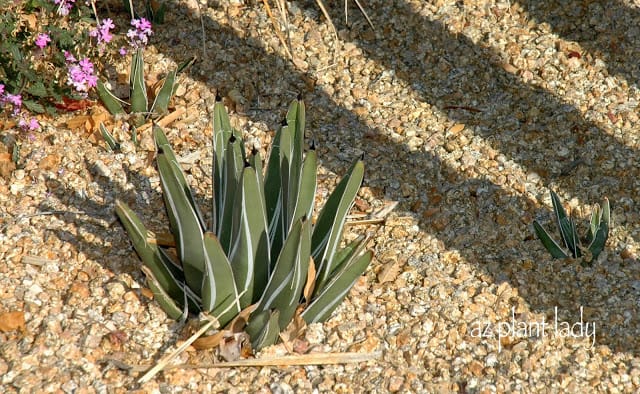
Victoria Agave (Agave victoria-reginae) parent plant and pups.
This is another of my favorite Agaves. How many pups can you see growing from the bigger parent plant? I see three, but there’s one more that’s not in the picture. This Agave is also highly prized and expensive. Most Victoria Agave plants don’t have pups, so I’m glad mine was kind enough to give me 4.
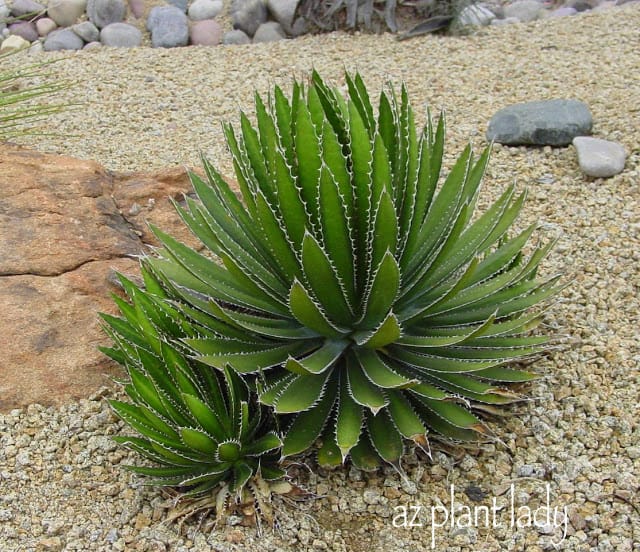
Agave lophantha with two pups.
Agave reproduce in two ways. One is by flowering at the end of their lifetime. The other way happens earlier in the Agave’s life span and that is by producing offsets called ‘pups’. The Agave sends out runners underground that produce the pups. The pups can be located right up next to the parent Agave or a few feet away.
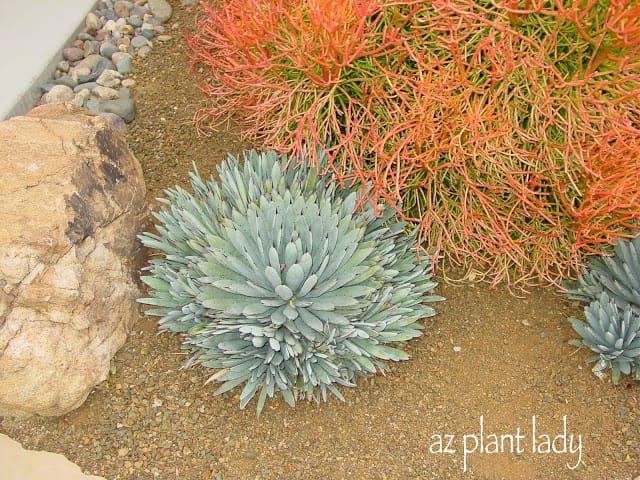
Agave macroacantha with many pups growing around it.
To remove, carefully expose the runner and cut with pruning shears or a sharp knife works well too. Before planting, the Agave pup needs to get a callus on the bottom. Leave it in a dry, shady place for at least a week. Agave pups can be planted out in the garden or placed in a container. Even better, you can give some to your friends.
I would do this in the spring or fall instead of the hot summer months, when the Agave pup is already having a hard time growing roots that can soak up water. But, that being said, Agave pups can be planted year-round.
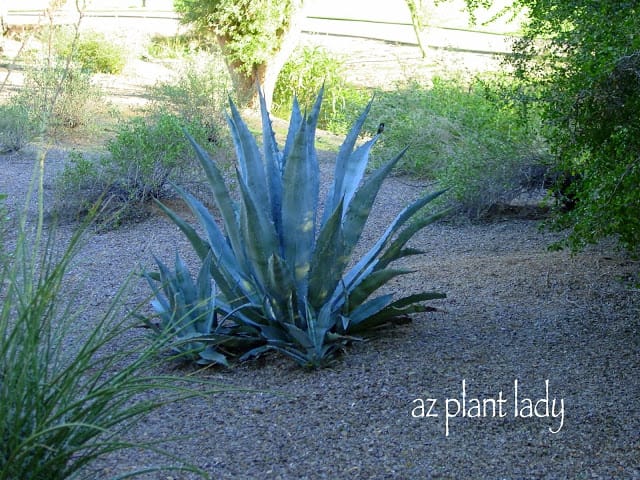
Agave americana with pups.
When most people think of Agave, they think of Agave americana (above). I really like the blue-gray leaves, but I’m not going to use this Agave because it makes so many pups. This requires a lot of upkeep because the pups need to be taken out often or they quickly grow into a mess. I’ve worked with a lot of clients who had to pull out their Agave americana because of this.
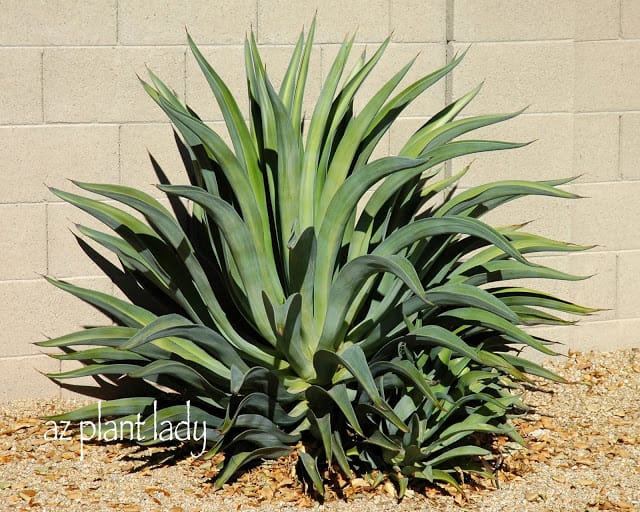
Agave desmettiana with two large pups. This Agave started life as a pup and was transplanted 4 years ago. It’s parent Agave flowered 3 years ago and died.
Okay, I admit, I am not the most organized gardener. I should have taken these large pups (on the right) and transplanted them last year. But, I promise I will as soon as it warms up. So, please do not wait to do this as long as I did. Agave pups do best when planted when they are small.
Instead of Agave americana, Agave desmettiana (above) is a good choice because it gets big without making too many pups. It also has smoother edges in contrast to Agave americana.

This picture has nothing to do with the post itself, but my dog, Missy, loves to pose for pictures whenever she can.

As does my son…
How to Re-Pot Agave Babies
FAQ
How do you remove and plant agave pups?
When to transplant agave pups?
How to propagate agave pups without roots?
How do you plant a agave PUP?
Before planting your Agave pup, it is important to prepare the soil. The soil should be well-draining, so it is best to mix in some sand or gravel to increase drainage. Additionally, you may want to add a layer of mulch to help retain moisture and protect the root system of the pup. Once the soil is prepared, it is time to plant the pup.
Can agave pups grow in a pot?
To avoid this, allow your agave pup to dry and heal for several days before planting. Agaves require excellent drainage and aeration. When potting Agave pups use a succulent soil mix or add extra pumice or lava rock, horticultural sand or gravel as an amendment. Place the plant’s crown high in the pot and don’t cover it with anything, even mulch.
What kind of soil do agave pups like?
Agave pups prefer soil that is well-draining and lightweight, such as cactus mix or succulent-specific potting soil. If your soil is too heavy, it can cause the roots to become waterlogged, leading to root rot.
How are agave pups attached to the mother plant?
The pups are attached to the mother plant by a thick, fleshy root. In the photo above, you can see that the pups are beginning to form their own roots, branching out to the side. At this point, cut the thick root and remove the little pup. Now this same adult agave had another pup, which was attached at the base.
- The Ultimate Guide to Growing Strawberries in Raised Beds - August 8, 2025
- No-Dig Garden Beds: The Easiest Way to Grow a Beautiful Garden - August 6, 2025
- How to Protect and Preserve Wood for Raised Garden Beds - August 6, 2025

